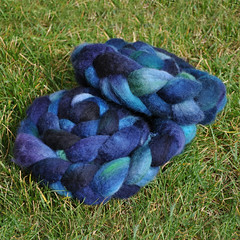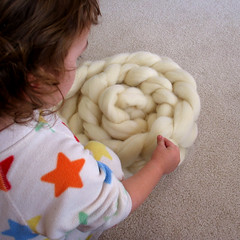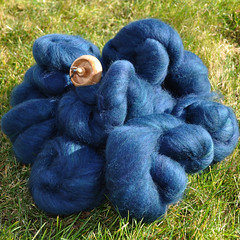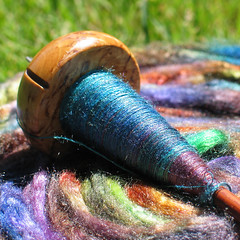Doesn't this look pretty? This is eight ounces (that's a half pound, or easily enough for two and maybe three pairs of socks) of Blue-faced Leicester commercially combed top. This was once a very plain white braid of fiber to which I applied dye, vinegar, and heat one muggy summer evening. What it produced was lovely to look at, but almost impossible to spin.
Here is the top in its original, pristine state. It's beautiful (as you can tell by my son admiring it back in March of 2009...back before we sheared off his curls!). BFL is a really lovely fiber. It is a longer staple fiber than merino, but can be almost as soft. It is considered to be harder-wearing and excellent for use in socks. I purchased it when I was just getting into the craft of spinning and really had no idea how I would use it, but it was considered an excellent "beginners fiber".
It marinated in my stash until later in the summer I had a few spare moments to dye. I processed the full eight ounces just as I had the smaller braids of Merino I had practiced on earlier. The colors came out nearly as I intended. But what I did not contend with was my own impatience. My efforts to rinse the over-saturated fiber clean resulted in compacting the top and slightly felting the fibers. It was not un-salvageable. But it was going to require stripping the top down and pre-drafting it until everything came loose enough again to work.
If I was going to do all that, I figured, I might as well drum-card the batch! I knew that the Eugene Textile Center would rent out their drum-carder for a full or half-day. And when I went in to use it, the informed me I could also take it home for a daily rate. Using the carder in-store is a juggling act of coordinating schedules. Using the drum-carder at home only requires naptime. Hurray for me!
So what I was able to obtain out of all this are twelve batts, each approximately 3/4 ounce (the most I could get onto the carder without a packing brush). To get this I broke my roving into tiny pieces and jumbled them all together. I created eight batts from the first half of the roving and eight from the second (I got better at packing as I had more practice through the day). I took all these and stacked them every-other one and then divided them in half lengthwise. I took chunks from these batts and re-carded them. And then I did the whole thing a third time, ending with twelve very smooth, well-blended batts. The depth of color does not fully present itself in the picture.
I've started to spin the first one recently and it is lovely. It isn't perfect (but I didn't expect perfection). But I did well listening to all the advice I could before-hand. I didn't over-load the licker-in. I cranked VERY slowly to allow all the fibers to add in smoothly without breaking or turning into tangled nepps. And it worked!
This project does not exist in a complete vacuum. I had decided that my dyed braid would be plied with silk I was already spinning and the resulting yarn would go into a design of my own creation. I think the carded single will pair even better with the silk and the sampling I have done so far yields a positively gorgeous yarn. It just may take me another year to finish it all!





No comments:
Post a Comment